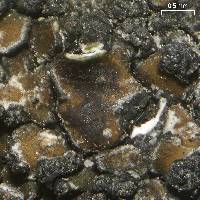
Consortium of Lichen Herbaria
- building a Global Consortium of Bryophytes and Lichens as keystones of cryptobiotic communities -
- Home
- Search
- Images
- Species Checklists
- US States: O-Z >
- US National Parks
- Central America
- South America
- US National Parks
- Southern Subpolar Region
|
|
|
|
Family: Mycosphaerellaceae
|
Nash, T.H., Ryan, B.D., Gries, C., Bungartz, F., (eds.) 2004. Lichen Flora of the Greater Sonoran Desert Region. Vol 2. Vegetative hyphae: light to dark brown, thick-walled, torulose, branched and anastomosed, (3.5-)6-9 µm in diam., forming a reticulum inside the epinecral layer of the host thallus, verruculose, BCr- Pseudothecia: blackish brown, immersed, globose, 40-60(-70) µm in diam. wall: upper and lower part brown, composed by 1-2 cell layers, mostly 5-10 µm thick; hyphae: 4.5-8 µm wide and 4.5-8 µm long hamathecium: lacking paraphysoids periphyses: sometimes very short or absent asci: bitunicate, broadly ellipsoid to oval, sessile, 19-22 x 13-15 µm, 8-spored; epiplasma: in young asci: I+ orange (dextrinoid reaction), with broad ocular chamber ascospores: medium to dark brown when mature, 1-septate, with cells of equal size, sometimes slightly constricted at the septa, oval, (9-)9.5-10.5(-12) x (4.5-)5-5.5(-6) µm, with rounded apices, 1-2-seriate inside of the ascus; epispore: smooth, thin-walled, only seldom forming a thin halo, BCr- Pycnidia: not observed. Hosts: the epinecral layer of the thallus of Immersaria athroocarpa, Lecidia atrobrunnea, L. leprosolimbata, L. paupercula; in Arizona and Colorado on Lecidia atrobrunnea World distribution: Europe, Asia (Nepal) and North America (U.S.A.) Sonoran distribution: known from Arizona, California and Colorado. Notes: Sphaerellothecium abditum and S. contextum have characteristic dark brown vegetative hyphal cells which develop thicker walls at the light-exposed upper side than at the lower side. |
Powered by Symbiota













